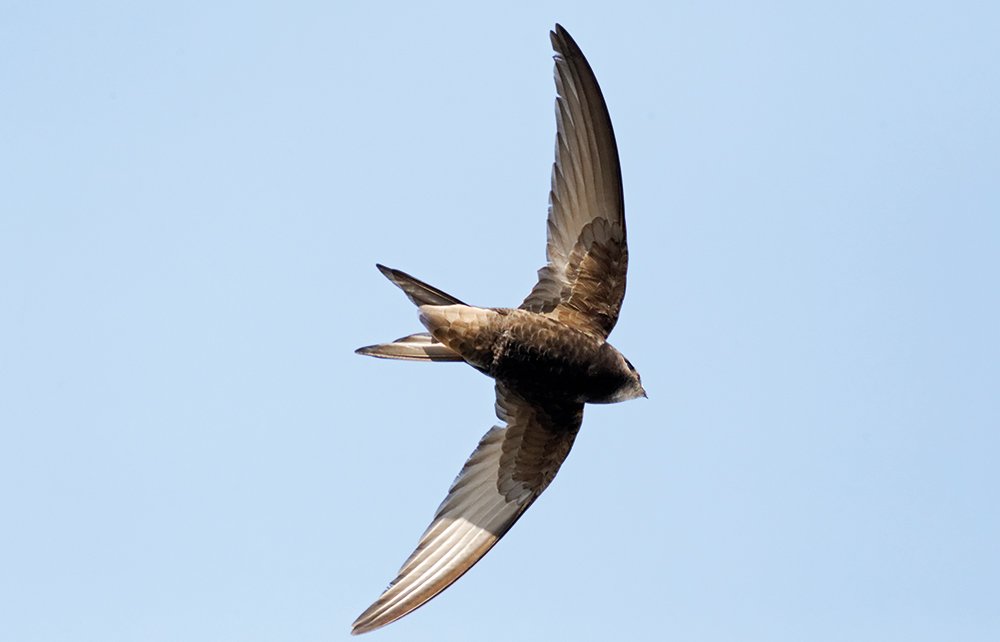It happens usually in the second week of May, between about the 8th and 12th (this year it was earlier, the 2nd): a distant sound, building as it approaches, and then the doppler dip as the first of the returning swifts screeches past the roof of our Cornish farmhouse. It’s the opening bracket of the summer months, one that closes with their departure just 12 weeks later. But it is a reminder, too, that while we might think of our house as home to two adult humans, two teenagers and a dog, it is also the habitat for several nesting swifts, swallows, house sparrows, pipistrelle bats, mice, occasional winter rodents and all manner of buzzing, creeping invertebrates, as well as the billions of microbes and bacteria that survive our admittedly liberal regime of cleaning.
Mark Cocker’s One Midsummer’s Day is not just a glorious celebration of swifts but of their place amid the panoply of life on Earth. He takes as his text the John Muir line: ‘When we try to pick out anything by itself, we find it hitched to everything else in the universe.’ Everything is intricately connected – nothing stands alone, particularly not us in our deluded state of Cartesian isolation. Plenty of fellow ecologists make the same point – it should be the creed of our age – but few do so with such deep and wide-ranging knowledge. Cocker is one of our greatest living naturalists, with decades of writing, research and campaigning behind him – and he brings to this vast subject a scientist’s rigour and a poet’s expansive vision.
Swifts can spend two years on the wing with only the briefest of landings
Swifts sit atop one of the high peaks of evolution, creatures of extraordinary physical prowess. They can spend two years on the wing with only the briefest of landings. When migrating they cover up to 1,000 kilometres per day. During their lifetime they might fly two million kilometres, yet they weigh no more than about four £1 coins. In proportion to their body weight they have the longest wings of any bird in the world. One species, the needle-tailed swift, has been recorded at 169 km/h, the fastest known level flight. But because of their constant movement, swifts are one of the least studied of all birds, existing not only on the fleeting periphery of our sight but, according to Cocker, ‘on the edge of knowability’.
His book is structured around a single day, the midsummer’s day of the title. He rises before dawn, catches the first birdsong, has breakfast, then lunch and potters about on the terrace. As the hours progress, he presents the full, startling picture of the swift, this little dynamo of life – its breeding, feeding, fledging and migrating. With the light fading, he is tilting back on his garden seat, peering up through binoculars ‘into the deep blue canyons that fall away through the orange-glowing clouds of evening’ – following the black dots of the high-flying swifts.
But his chosen timescale is also some 3.8 billion years. Each living entity– swifts, humans, everything – goes back to the moment when monocellular life emerged, probably deep underwater where superheated metal sulphides spewed from hydrothermal vents. Nothing much happened for three billion years until single-cell organisms became multi-cellular. From that moment on there was an acceleration, as life became manifest in multiple shapes – plants and birds and mammals and then, much more recently, the two-legged, big-brained animal, able suddenly and ingeniously to unravel the miraculous sequence of organisms while at the same time giving most of them a hefty and fatal sideswipe.
‘Swifts are insects,’ Cocker claims, in the sense of being what they eat. He calculates that the UK’s summer swifts take back to their young an aggregate of some 3.6 billion insects a day. Juxtapose that with another figure – just two teaspoons of neonicotinoid (the most commonly used insecticide globally) can kill 2.5 billion invertebrates – and it is easy to understand the recent collapse not just of swift populations but most insectivores. Swifts have declined in the UK by some 60 per cent since the 1990s. Pesticides are one possible reason, loss of nesting sites another; but the specific cause has not been identified.
And that is Cocker’s big point. Isolating causes and targeting solutions are part of the same destructive habit of separation. The truth is that the demise of swifts is the result of the entire ‘matrix of anthropogenic problems’ – climate change, habitat destruction, industrial farming, pollution, population pressure et al. Watch a swift spin towards you on a summer’s evening and you are witnessing the whole of creation; think of its threatened extinction and you hear the entire current catastrophe sweeping overhead.
Last year saw the publication of Charles Foster’s invigorating book on swifts, The Screaming Sky, followed swiftly by another, Sarah Gibson’s Swifts and Us. You’d think swifts had been covered. But One Midsummer’s Day feels both urgent and necessary. From the microverse of the soil to the mysteries of migration, Cocker gives us the grand sweep, intricate details of avian zoology and the full horrors of ecocide. But he leaves us on a high note. When people ask him about hope, he admits that he struggles to answer, not because there is none but because ‘hope is overwhelming, everywhere and without end. Open the door.’






Comments